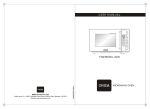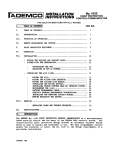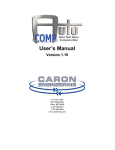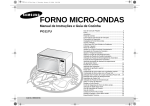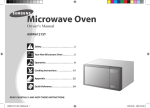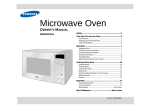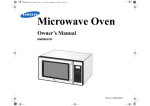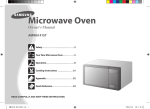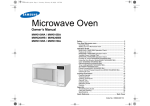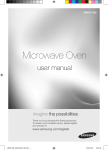Download Samsung AMW784WE User Manual
Transcript
Microwave Oven Owner’s Manual AMW784WE Code No.: DE68-03427C AMW784WE_XAP_03427C.indd 1 2008-06-26 ¿ÀÈÄ 4:01:17 Safety Precautions to Avoid Important Safety Instructions Possible Exposure to Excessive Microwave Energy: When using any electrical appliance, basic safety precautions should be followed, including the following: WARNING To reduce risk of burns, electric shock, fire, personal injury or exposure to excessive microwave energy: • Read all safety instructions before using the appliance. • Read and follow the specific “PRECAUTIONS TO AVOID POSSIBLE EXPOSURE TO EXCESSIVE MICROWAVE ENERGY” on this page. • This appliance must be grounded. Connect only to properly grounded outlets. See “IMPORTANT GROUNDING INSTRUCTIONS” on page 3 of this manual. • Install or place this appliance only in accordance with the installation instructions provided. • Some items, like whole eggs and food in sealed containers, may explode if heated in this oven. • Use this appliance only for its intended use as described in the manual. Do not use corrosive chemicals or vapors in this appliance. This type of oven is specifically designed to heat, cook, or dry food. It is not designed for industrial or laboratory use. • As with any appliance, close supervision is necessary when used by children. • Do not operate this appliance if it has a damaged cord or plug, if it is not working properly, or if it has been damaged. • This appliance should be serviced only by qualified service personnel. Contact the nearest authorized service facility for examination, repair, or adjustment. • Do not cover or block any of the openings on this appliance. (A) Do not attempt to operate this oven with the door open since open-door operation can result in harmful exposure to microwave energy. It is important not to defeat or tamper with the safety interlocks. (B) Do not place any object between the oven front face and the door or allow soil or cleaner residue to accumulate on sealing surfaces. (C) Do not operate the oven if it is damaged. It is particularly important that the oven door close properly and that there is no damage to the (1) Door (bent or dented), (2) Hinges and latches (broken or loosened), (3) Door seals and sealing surfaces. (D) The oven should not be adjusted or repaired by anyone except properly qualified service personnel. WARNING Always observe Safety Precautions when using your oven. Never try to repair the oven on your own - there is dangerous voltage inside. SAVE THESE INSTRUCTIONS AMW784WE_XAP_03427C.indd 2 2008-06-26 ¿ÀÈÄ 4:01:17 Safety • • • • • • • • • • • • • Important Grounding Instructions Do not store this appliance outdoors. Do not use near water - for example, near a kitchen sink, in a wet basement, or near a swimming pool, etc. Keep the inside of the oven clean. Food particles or spattered oils stuck to the oven walls or floor can cause paint damage and reduce the efficiency of the oven. Do not immerse cord or plug in water. Keep cord away from heated surfaces. Do not let cord hang over edge of table or counter. When cleaning door and oven surfaces, use only mild, nonabrasive soaps or detergents applied with a sponge or soft cloth. To reduce the risk of fire in the oven: a. Do not overcook food. Watch appliance carefully if paper, plastic, or other combustible materials are inside. b. Remove wire twist-ties from plastic cooking bags before placing bags in oven. c. If materials inside the oven ignite, keep the oven door closed, turn the oven off, disconnect the power cord, or shut off the power at the fuse or circuit breaker panel. d. Do not use the oven compartment for storage purposes. Do not leave paper products, cooking utensils, or food in the oven when not in use. Do not try to preheat oven or operate while empty. Do not cook without the glass tray in place on the oven floor. Food will not cook properly without the tray. Do not defrost frozen beverages in narrow-necked bottles. The containers can break. Dishes and containers can become hot. Handle with care. Carefully remove container coverings, directing steam away from hands and face. Remove lids from baby food before heating. After heating baby food, stir well and test temperature by tasting before serving. This appliance must be grounded. In the event of an electrical short circuit, grounding reduces the risk of electric shock by providing an escape wire for the electrical current. This appliance is equipped with a cord that includes a grounding wire and a grounding plug. The plug must be plugged into an outlet that is properly installed and grounded. Plug the three-prong power cord into a properly grounded outlet of standard 115-120 voltage, 60 Hz. Your oven should be the only appliance on this circuit. SAVE THESE INSTRUCTIONS AMW784WE_XAP_03427C.indd 3 2008-06-26 ¿ÀÈÄ 4:01:17 Safety WARNING WARNING Improper use of the grounding plug can result in a risk of electric shock. Consult a qualified electrician or servicer if you do not understand the grounding instructions or if you are not sure if the appliance is properly grounded. Do not cut or remove the third (ground) prong from the power cord under any circumstances. Use of Extension Cords Connect the oven to a 20A circuit. When connecting the oven to a 15A circuit, make sure that circuit breaker is operable. Note A short power-supply cord is provided to reduce the risk of becoming entangled in or tripping over a longer cord. Longer cord sets or extension cords are available and may be used if care is exercised in their use. If a long cord or extension cord is used: 1. 2. 3. Liquids, such as water, coffee, or tea are able to be overheated beyond the boiling point without appearing to be boiling. Visible bubbling or boiling when the container is removed from the microwave oven is not always present. THIS COULD RESULT IN VERY HOT LIQUIDS SUDDENLY BOILING OVER WHEN THE CONTAINER IS DISTURBED OR A SPOON OR OTHER UTENSIL IS INSERTED INTO THE LIQUID. The marked electrical rating of the cord set or extension cord should be at least as great as the electrical rating of the appliance. The extension cord must be a grounding-type 3-wire cord and it must be plugged into a 3-slot outlet. The longer cord should be arranged so that it will not drape over the counter top or tabletop where it can be pulled on by children or tripped over accidentally. If you use an extension cord, the interior light may flicker and the blower may vary when the microwave oven is on. Cooking times may be longer, too. To reduce the risk of injury to persons: 1. 2. 3. 4. Do not overheat the liquid. Stir the liquid both before and halfway through heating it. Do not use straight-sided containers with narrow necks. After heating, allow the container to stand in the microwave oven for a short time before removing the container. 5. Use extreme care when inserting a spoon or other utensil into the container. SAVE THESE INSTRUCTIONS AMW784WE_XAP_03427C.indd 4 2008-06-26 ¿ÀÈÄ 4:01:17 Your New Microwave oven Table of Contents Checking Parts Safety. . . . . . . . . . . . . . . . . . . . . . . . . . . . . . . . . . . . . . . . . . . . . . . . . . . . . . . . . . . . . . . . . . . . . . . . . 2 Your New Microwave oven. . . . . . . . . . . . . . . . . . . . . . . . . . . . . . . . . . . . . . . . . . . . . . . . . . . . . . . . 5 Checking Parts. . . . . . . . . . . . . . . . . . . . . . . . . . . . . . . . . . . . . . . . . . . . . . . . . . . . . . . . . . . . . . . . 5 Table of Contents. . . . . . . . . . . . . . . . . . . . . . . . . . . . . . . . . . . . . . . . . . . . . . . . . . . . . . . . . . . . . . 5 Guarantee and Service Information. . . . . . . . . . . . . . . . . . . . . . . . . . . . . . . . . . . . . . . . . . . . . . . . 6 Setting Up Your Microwave Oven. . . . . . . . . . . . . . . . . . . . . . . . . . . . . . . . . . . . . . . . . . . . . . . . . . 6 Control Panel Buttons. . . . . . . . . . . . . . . . . . . . . . . . . . . . . . . . . . . . . . . . . . . . . . . . . . . . . . . . . . . 7 Operation. . . . . . . . . . . . . . . . . . . . . . . . . . . . . . . . . . . . . . . . . . . . . . . . . . . . . . . . . . . . . . . . . . . . . . 8 Start-up and selection of the measuring system. . . . . . . . . . . . . . . . . . . . . . . . . . . . . . . . . . . . . . . 8 Setting the Clock. . . . . . . . . . . . . . . . . . . . . . . . . . . . . . . . . . . . . . . . . . . . . . . . . . . . . . . . . . . . . . . 8 Using the Pause/Cancel Button. . . . . . . . . . . . . . . . . . . . . . . . . . . . . . . . . . . . . . . . . . . . . . . . . . . 9 Using the Instant Cook Buttons . . . . . . . . . . . . . . . . . . . . . . . . . . . . . . . . . . . . . . . . . . . . . . . . . . . 9 Defrosting Automatically. . . . . . . . . . . . . . . . . . . . . . . . . . . . . . . . . . . . . . . . . . . . . . . . . . . . . . . . 10 Using the +30 Sec. Button. . . . . . . . . . . . . . . . . . . . . . . . . . . . . . . . . . . . . . . . . . . . . . . . . . . . . . 10 Setting Cooking Times & Power Levels. . . . . . . . . . . . . . . . . . . . . . . . . . . . . . . . . . . . . . . . . . . . 10 One-stage Cooking. . . . . . . . . . . . . . . . . . . . . . . . . . . . . . . . . . . . . . . . . . . . . . . . . . . . . . . . . . . . 10 Multi-stage Cooking. . . . . . . . . . . . . . . . . . . . . . . . . . . . . . . . . . . . . . . . . . . . . . . . . . . . . . . . . . . 11 Using the More/Less Buttons. . . . . . . . . . . . . . . . . . . . . . . . . . . . . . . . . . . . . . . . . . . . . . . . . . . . 11 Demonstration Mode . . . . . . . . . . . . . . . . . . . . . . . . . . . . . . . . . . . . . . . . . . . . . . . . . . . . . . . . . . 11 Setting the Child Protection Lock. . . . . . . . . . . . . . . . . . . . . . . . . . . . . . . . . . . . . . . . . . . . . . . . . 11 Cooking Instructions. . . . . . . . . . . . . . . . . . . . . . . . . . . . . . . . . . . . . . . . . . . . . . . . . . . . . . . . . . . . 12 Cooking Utensils. . . . . . . . . . . . . . . . . . . . . . . . . . . . . . . . . . . . . . . . . . . . . . . . . . . . . . . . . . . . . . 12 Testing Utensils . . . . . . . . . . . . . . . . . . . . . . . . . . . . . . . . . . . . . . . . . . . . . . . . . . . . . . . . . . . . . . 12 Cooking Techniques. . . . . . . . . . . . . . . . . . . . . . . . . . . . . . . . . . . . . . . . . . . . . . . . . . . . . . . . . . . 13 Cooking Guide. . . . . . . . . . . . . . . . . . . . . . . . . . . . . . . . . . . . . . . . . . . . . . . . . . . . . . . . . . . . . . . 15 Recipes. . . . . . . . . . . . . . . . . . . . . . . . . . . . . . . . . . . . . . . . . . . . . . . . . . . . . . . . . . . . . . . . . . . . . 17 Appendix . . . . . . . . . . . . . . . . . . . . . . . . . . . . . . . . . . . . . . . . . . . . . . . . . . . . . . . . . . . . . . . . . . . . . 19 Troubleshooting Guide. . . . . . . . . . . . . . . . . . . . . . . . . . . . . . . . . . . . . . . . . . . . . . . . . . . . . . . . . . . . . . . 19 Care and Cleaning. . . . . . . . . . . . . . . . . . . . . . . . . . . . . . . . . . . . . . . . . . . . . . . . . . . . . . . . . . . . . . . . . . 19 Quick Reference . . . . . . . . . . . . . . . . . . . . . . . . . . . . . . . . . . . . . . . . . . . . . . . . . . . . . . . . . . . . . . . 20 Specifications. . . . . . . . . . . . . . . . . . . . . . . . . . . . . . . . . . . . . . . . . . . . . . . . . . . . . . . . . . . . . . . . 20 Unpack your microwave oven and check to make sure that you have all the parts shown here. If any part is missing or broken, call your dealer. Microwave oven Glass tray Roller guide ring Registration card Instruction manual AMW784WE_XAP_03427C.indd 5 2008-06-26 ¿ÀÈÄ 4:01:18 Your New Microwave oven Guarantee and Service Information Setting Up Your Microwave Oven To achieve a better service, complete the following form and send it by mail. 1. If the registration card is lost, you can call Samsung Electronics Latin America-Panama, or register on line (www.samsunglatin.com). Make sure there is adequate ventilation for your oven by leaving at least four inches of space behind, above, and to the side of the oven. When you contact Samsung, give the model number you will find on the rear and the bottom of the product. Please keep this number for future clarifications. Keep this information in a safe place to identify the purchase in the event of robbery or loss and if you need to consult an assistance service. MODEL NUMBER _________________________________________ SERIAL NUMBER _________________________________________ Place the oven on a flat, sturdy surface and plug the cord into a grounded outlet. 2. 3. 4. Open the oven door by pressing the button below the control panel. 5. Place the glass tray on top of the ring so that the three glass tabs in the center of the tray fit securely into the tabs on the floor of the oven. Wipe the inside of the oven with a damp cloth. Place the pre-assembled ring in the indentation in the center of the oven. PURCHASE DATE _________________________________________ PURCHASED IN _________________________________________ This guarantee will only be valid in any Authorised Samsung Centre. If you require a service guarantee, complete the data required above and go to an authorised Samsung service centre. AMW784WE_XAP_03427C.indd 6 2008-06-26 ¿ÀÈÄ 4:01:18 Your New Microwave oven Control Panel Buttons AMW784WE 1. Clock p.8 2. +30 Sec. 3. Instant Cook Buttons p.10 p.9 4. Auto Defrost p.10 Sets current time Instant settings to cook popular foods. 2 Sets weight of food to be defrosted. 5. Number Buttons Sets cooking times or amounts and power levels other than high. 3 6. Power Level p.10 7. Pause/Cancel p.9 Press this pad to set a power level other than high. Press to pause oven or correct a mistake. 4 8. Start Press to start cooking. 9 9 More/Less 6 Increase or decrease cooking time. p.11 5 1 7 8 AMW784WE_XAP_03427C.indd 7 2008-06-26 ¿ÀÈÄ 4:01:19 Operation Start-up and selection of the measuring system Setting the Clock After connecting the power cable in a socket for the first time or after an interruption in the power supply, the screen will show “ ”. The measuring system may be selected at this time. You can select pounds (Lbs.) or kilograms (kg). To do this: 1. 6. 2. Press “0” immediately after connecting the microwave. The screen will show “Gr”. To change to other measuring systems, you must disconnect the microwave and connect it once more. Press the Clock button. The display will show: Use the Number buttons to enter the current time. You must press at least three numbers to set the clock. If the current time is 5:00 enter, 5,0,0. On Lock Demo 7. 3. Press “0” repeatedly to select the measuring system you wish to use: If you continue pressing “0”, the screen will show the options repeatedly in the described order. kg g oz I II lbs cup Press Clock again. A colon will blink, indicating that the time is set. LOCK COMBI If ON there is aDEMO powerGRILL interruption, you will need to reset the clock. You can check the current time while cooking is in progress by pressing the Clock button. Kg g Oz. Lbs. Cup Having selected the measuring system you wish to use, press the Pause/Cancel button to finish the procedure. Or press CLOCK to adjust the clock. AMW784WE_XAP_03427C.indd 8 2008-06-26 ¿ÀÈÄ 4:01:19 Operation Using the Pause/Cancel Button Instant Cook Chart Item The Pause/Cancel button allows you to clear instructions you have entered. It also allows you to pause the oven’s cooking cycle, so that you can check the food. Weight Remarks Regular 100g • Use one microwave-only bag of popcorn. Pop only one bag at a time. (3.5 oz.), • To pause the oven during cooking: press Pause/Cancel once. To restart, press Start. Popcorn Light Regular • Use caution when removing and opening hot bag from oven. • To stop cooking, erase instructions, and return the oven display to the time of day: press Pause/Cancel twice. 85-100g • To correct a mistake you have just entered: press Pause/Cancel once, then re-enter the instructions. 1 EA, 2 EA • Prick each potato several times with fork. 3 EA, 4 EA • Place on turntable in spoke-like fashion. (3.0-3.5 oz.) Potato • Remove from oven, wrap in foil and let stand 3-5 min. Using the Instant Cook Buttons 1. Press the Instant Cook button corresponding to the food you are cooking (Popcorn, for example). The display shows the first serving size. 2. Press the button repeatedly to select the serving size you want. The display will cycle through all available serving sizes. Once you select the correct serving size, the microwave will begin cooking automatically. 1 serving Fresh Vegetable 2 servings • Place the vegetable into a casserole and add some water. • Cover during cooking and stir before standing. 3 servings 4 servings ½ cup Boil Water 1 cup 2 cups Melt Cheese Frozen Dinner 90g (3.0Lbs) 230-290 g • Measure liquid; pour into microwave-safe container that is 2 times larger than amount of liquid. Example: For 1 cup liquid use a 2 cup or larger dish. • Stir well before and after heating to prevent erupting. • Unwrap cream cheese and place on microwave-safe dish. (8-10 oz.) • Let stand 1-2 min. • Remove package from outer wrapping and follow package instructions for covering and standing. 290-340 g • After cooking, let stand 1-3 minutes. (10-12 oz.) AMW784WE_XAP_03427C.indd 9 2008-06-26 ¿ÀÈÄ 4:01:19 Operation Defrosting Automatically Setting Cooking Times & Power Levels To thaw frozen food, set the weight of the food and the microwave automatically sets the defrosting time, power level and standing time. Your microwave allows you to set up to two different stages of cooking, each with its own time length and power level. The power level button lets you control the heating intensity from Warm (1) to High (0).Cocinado de una etapa 1. Press the Auto Defrost button. The display shows “0.5 lbs.” (0.2Kg if you have set your oven for metric measure). One-stage Cooking 2. To set the weight of your food, press the Auto Defrost button repeatedly. This increases the weight by 0.5 lb increments, up to 6.0 lbs (The Auto Defrost button will increase the weight by 0.2Kg up to 2.6kg if you are using metric measurement). For simple one-stage cooking, you only need to set a cooking time. The power level is automatically set to High. If you want to set the power to any other level, you must set it using the Power Level button. You can also use the number buttons to enter the weight of the food directly. 1. Use the number buttons to set a cooking time. You can set a time from one second to 99 minutes, 99 seconds. To set a time over one minute, enter the seconds too. For example, to set 20 minutes, enter 2, 0, 0, 0 . 3. 4. Press the Pause/Cancel button, open the oven door, and turn the food over. 2. If you want to set the power level to something other than High, press the Power Level button, then use the number buttons to enter a power level. Power Levels: The oven calculates the defrosting time and starts automatically. Twice during defrosting, the oven will beep to let you know to turn the food over. Press the Start button to resume defrosting. • See page 15 for the Defrosting Guide. Using the +30 Sec. Button This button offers a convenient way to heat food in one-minute increments at the High power level. 1. 1 = PL : 10 (Warm) 6 = PL : 60 (Simmer) 2 = PL : 20 (Low) 7 = PL : 70 (Medium High) 3 = PL : 30 (Defrost) 8 = PL : 80 (Reheat) 4 = PL : 40 (Medium Low)) 9 = PL : 90 (Saute) 5 = PL : 50 (Medium) 0 = PL : Hi (High) Press the Start button to begin cooking. If you want to change the power level, press Pause/Cancel before you press Start, and re-enter all of the instructions. Press the +30 Sec. button once for each minute you wish to cook the food. For example, press it twice for two minutes. The time will display, and the oven starts automatically. Add minutes to a program in progress by pressing the +30 Sec. button for each minute you want to add. 10 AMW784WE_XAP_03427C.indd 10 2008-06-26 ¿ÀÈÄ 4:01:19 Operation Multi-stage Cooking Demonstration Mode Some recipes require different stages of cooking at different temperatures. You can set multiple stages of cooking with your microwave. You can use the Demonstration Mode to see how your microwave oven operates without the oven heating. 1. Follow steps 1 and 2 in the “One-Stage Cooking” section on the previous page. 1. To set the power level at High for a stage of cooking, press the Power Level button twice. When entering more than one cooking stage, the Power Level button must be pressed before the second cooking stage can be entered. 2. 3. Use the number buttons to set a second cooking time. 4. Press Start to begin cooking. Hold the 0 button and then press the 1 button. To turn demo mode off, repeat step 1 above. Setting the Child Protection Lock You can lock your microwave oven so it can’t be used by unsupervised children. 1. Hold the “0” button and then press the 2 button. Press the Power Level button, then use the number buttons to set the power level of the second stage of cooking. Using the More/Less Buttons At this point, the microwave oven cannot be used until it is unlocked. To unlock it, repeat step 1 above. The More/Less buttons allow you to adjust pre-set cooking times. They only work in the Instant, Time Cook modes. Use the More/Less button only after you have already begun cooking with one of these procedures. 1. 2. To ADD more time to an automatic cooking procedure: Press the More (9) button. To REDUCE the time of an automatic cooking procedure: Press the Less (1) button. 11 AMW784WE_XAP_03427C.indd 11 2008-06-26 ¿ÀÈÄ 4:01:19 Cooking Instructions Cooking Utensils Not Recommended Recommended Use • Glass jars and bottles - Regular glass is too thin to be used in a microwave, and can shatter. • Paper bags - These are a fire hazard, except for popcorn bags that are designed for microwave use. • Glass and glass-ceramic bowls and dishes - Use for heating or cooking. • Microwave browning dish - Use to brown the exterior of small items such as steaks, chops, or pancakes. Follow the directions provided with your browning dish. • Styrofoam plates and cups - These can melt and leave an unhealthy residue on food. • Microwavable plastic wrap - Use to retain steam. Leave a small opening for some steam to escape and avoid placing it directly on the food. • Plastic storage and food containers - Containers such as margarine tubs can melt in the microwave. • Wax paper - Use as a cover to prevent spattering. • Metal utensils - These can damage your oven. Remove all metal before cooking. • Paper towels and napkins - Use for short-term heating and covering; they absorb excess moisture and prevent spattering. Do not use recycled paper towels, which may contain metal and can catch fire. Testing Utensils • Paper plates and cups - Use for short-term heating at low temperatures. Do not use recycled paper, which may contain metal and can catch fire. If you are not sure whether a dish is microwave-safe or not, you can perform this test: 1. • Thermometers - Use only those labeled “Microwave Safe” and follow all directions. Check the food in several places. Conventional thermometers may be used once the food has been removed from the oven. Fill a 1 cup glass measuring cup with water and put it inside your oven, next to the dish you want to test: Limited Use • Aluminum foil - Use narrow strips of foil to prevent overcooking of exposed areas. Using too much foil can damage your oven, so be careful. • Ceramic, porcelain, and stoneware - Use these if they are labeled “Microwave Safe.” If they are not labeled, test them to make sure they can be used safely. Never use dishes with metallic trim. 2. • Plastic - Use only if labeled “Microwave Safe.” Other plastics can melt. • Straw, wicker, and wood - Use only for short-term heating, as they can be flammable. Press the +30 Sec. button once to heat them for one 30sec at High power. The water should be warm and the dish you are testing should be cool. If the dish is warm, then it is absorbing microwave energy and is not acceptable for use in the microwave. 12 AMW784WE_XAP_03427C.indd 12 2008-06-26 ¿ÀÈÄ 4:01:20 Cooking Instructions Cooking Techniques Adding Moisture Stirring Microwave energy is attracted to water molecules. Food that is uneven in moisture content should be covered or allowed to stand so that the heat disperses evenly. Add a small amount of water to dry food to help it cook. Stir foods such as casseroles and vegetables while cooking to distribute heat evenly. Food at the outside of the dish absorbs more energy and heats more quickly, so stir from the outside to the center. The oven will turn off when you open the door to stir your food. General Tips • Dense foods, such as potatoes, take longer to heat than lighter foods. Foods with a delicate texture should be heated at a low power level to avoid becoming tough. Arrangement • Altitude and the type of cookware you are using can affect cooking time. When using a new recipe, use the minimum cooking time and check the food occasionally to prevent overcooking. Arrange unevenly shaped foods, such as chicken pieces or chops, with the thicker, meatier parts toward the outside of the turntable where they receive more microwave energy. To prevent overcooking, place thin or delicate parts toward the center of the turntable. • Foods with a non-porous skin or shell, such as potatoes, eggs, or hot dogs, should be pierced to prevent bursting. Shielding • Frying with heating oil or fat is not recommended. Fat and oil can suddenly boil over and cause severe burns. Shield food with narrow strips of aluminum foil to prevent overcooking. Areas that need shielding include poultry wing-tips, the ends of poultry legs, and corners of square baking dishes. Use only small amounts of aluminum foil. Larger amounts can damage your oven. • Some ingredients heat faster than others. For example, the jelly inside a jelly doughnut will be hotter than the dough. Keep this in mind to avoid burns. • Home canning in the microwave oven is not recommended because all harmful bacteria may not be destroyed by the microwave heating process. Turning • Although microwaves do not heat the cookware, the heat is often transferred to the cookware. Always use pot holders when removing food from the microwave and instruct children to do the same. Turn foods over midway through cooking to expose all parts to microwave energy. This is especially important with large items such as roasts. Standing Foods cooked in the microwave build up internal heat and continue to cook for a few minutes after the oven stops. Let foods stand to complete cooking, especially foods such as roasts and whole vegetables. Roasts need this time to complete cooking in the center without overcooking the outer areas. All liquids, such as soup or hot chocolate, should be shaken or stirred when cooking is complete. Let liquids stand a moment before serving. When heating baby food, stir well and test the temperature before serving. 13 AMW784WE_XAP_03427C.indd 13 2008-06-26 ¿ÀÈÄ 4:01:20 Cooking Instructions Auto Defrosting Guide Notes • Follow the instructions below when defrosting different types of food. Check foods when the oven signals. After the final stage, small sections may still be icy; let them stand to continue thawing. Do not defrost until all ice crystals have thawed. Shielding roasts and steaks with small pieces of foil prevents the edges from cooking before the center of the food has defrosted. Use narrow, flat, smooth strips of aluminum foil to cover the edges and thinner sections of the food. Food Standard Amount Procedure Roast Beef, Pork. 1100 g - 2600g Start with the food placed fat side down. After each stage, turn the food over and shield any warm portions with narrow strips of aluminum foil. Steaks, Chops, Fish 200 g - 1300g After each stage, rearrange the food. If there are any warm or thawed portions of food, shield them with narrow flat pieces of aluminum foil. Remove any pieces of food that are nearly defrosted. Let stand, covered, for 5-10 minutes. Ground Meat 200 g - 1300g After each stage, remove any pieces of food that are nearly defrosted. Let stand, covered with foil, for 5-10 minutes. Whole Chicken 1100 g - 2600g Remove giblets before freezing poultry. Start defrosting with the breast side down. After the first stage, turn the chicken over and shield any warm portions with narrow strips of aluminum foil. After the second stage, again shield any warm portions with narrow strips of aluminum foil. Let stand, covered, for 30-60 minutes in the refrigerator. Chicken Pieces 200 g - 1300g After each stage, rearrange or remove any pieces of food that are nearly defrosted. Let stand for 10-20 minutes. 14 AMW784WE_XAP_03427C.indd 14 2008-06-26 ¿ÀÈÄ 4:01:20 Cooking Instructions Cooking Guide GUIDE for Cooking Poultry in Your Microwave • Place poultry on a microwave-safe roasting rack in a microwave-safe dish. GUIDE for Cooking Meat in Your Microwave • Cover poultry with wax paper to prevent spattering. • Place meat on a microwave-safe roasting rack in a microwave-safe dish. • Use aluminum foil to shield bone tips, thin meat areas, or areas that start to overcook. • Start meat fat-side down. Use narrow strips of aluminum foil to shield any bone tips or thin meat areas. • Check the temperature in several places before letting the poultry stand the recommended time. • Check the temperature in several places before letting the meat stand the recommended time. Food • The following temperatures are removal temperatures. The temperature of the food will rise during the standing time. Food Cook Time/Power Level Roast Beef Cooking Time: Boneless 7-10 min. / 454g for 46.1˚C - Rare Up to 1.8 kg. 8-12 min. / 454g for 48.9˚C - Medium 9-14 min. / 454g for 62.7˚C - Well Done Directions Place roast fat-side down on roasting rack. Cover with wax paper. Turn over when cooking time is half up. Let stand 10 min. Cooking Time: Boneless or bone-in 11-14 min. / 454g for 71.2˚C - Well Done Up to 1.8 kg Power Level: High(0) for first 5 min., then Medium(5). Bacon Cooking Time: 2-6 slices 2 slices: 11/2- 13/4 min. 4 slices: 3- 31/2 min. 6 slices: 41/2-51/2 min. Whole Chicken. Cooking Time: up to 1.8kg 76.6˚C - 82.2˚C 6-9 min. / 454g for Power Level: Medium High(7) Power Level: High(0) for first 5 min., then Medium(5). Pork Cook Time/Power Level Chicken Pieces Cooking Time: up to 907g 82.2˚C - Dark meat 6-9 min. / 454g 76.6˚C - Light meat Place roast fat-side down on roasting rack. Cover with vented plastic wrap. Turn over when cooking time is half up. Let stand 10 min. Power Level: Medium High(7) Directions Place chicken breast-side down on roasting rack. Cover with wax paper. Turn over when cooking time is half up. Cook until juices run clear and meat near the bone is no longer pink. Let stand 5-10 min. Place chicken bone-side down on dish, with the thickest portions towards the outside of the dish. Cover with wax paper. Turn over when cooking time is half up. Cook until juices run clear and meat near the bone is no longer pink. Let stand 5-10 min. Arrange slices on roasting rack or a dish lined with paper-towel. Cover with paper towel. Microwave until crisp. Power Level: High(0). 15 AMW784WE_XAP_03427C.indd 15 2008-06-26 ¿ÀÈÄ 4:01:20 Cooking Instructions Guide for Cooking Seafood in Your Microwave Guide for Cooking Eggs in Your Microwave • Cook fish until it flakes easily with a fork. • Never cook eggs in the shell, and never warm hard-cooked eggs in the shell; they can explode. -• Place fish on a microwave-safe roasting rack in a microwave-safe dish. • Always pierce whole eggs to keep them from bursting. • Use a tight cover to steam fish. A lighter cover of wax paper or paper towel provides less steaming. • Cook eggs just until set; they become tough if overcooked. • Do not overcook fish; check it at minimum cooking time.21/2 Food Cook Time/Power Level Directions Steaks Cooking Time: Up to 680g 6-10 min. / 454g Arrange steaks on roasting rack with meaty portions towards the outside of rack. Cover with wax paper. Turn over and rearrange when cooking time is half up. Cook until fish flakes easily with a fork. Let stand 3-5 min. Power Level: Medium-High(7). Fillets Cooking Time: Up to 680g 3-7 min. / 454g Power Level: Medium-High(7). Shrimp Cooking Time: Up to 680g 3-51/2 min. / 454g Power Level: Medium-High(7). Guide for Cooking Vegetables in Your Microwave • Vegetables should be washed just before cooking. Often, no extra water is needed. If dense vegetables such as potatoes, carrots and green beans are being cooked, add about ¼ cup water. • Small vegetables (sliced carrots, peas, lima beans, etc.) will cook faster than larger ones. Arrange fillets in a baking dish, turning any thin pieces under. Cover with wax paper. If over ? inch thick, turn over and rearrange when cooking time is half up. Cook until fish flakes easily with a fork. Let stand 2-3 min. • Whole vegetables, such as potatoes, acorn squash or corn on the cob, should be arranged in a circle on the turntable before cooking. They will cook more evenly if turned over after half the cooking time. • Always place vegetables like asparagus and broccoli with the stem ends pointing towards the edge of the dish and the tips toward the center. Arrange shrimp in a baking dish without overlapping or layering. Cover with wax paper. Cook until firm and opaque, stirring 2 or 3 times. Let stand 5 min. • When cooking cut vegetables, always cover the dish with a lid or vented microwavable plastic wrap. • Whole, unpeeled vegetables such as potatoes, squash, eggplant, etc., should have their skin pricked in several spots before cooking to prevent them from bursting. • For more even cooking, stir or rearrange whole vegetables halfway through the cooking time. • Generally, the denser the food, the longer the standing time. (Standing time refers to the time necessary for dense, large foods and vegetables to finish cooking after they come out of the oven.) A baked potato can stand on the counter for five minutes before cooking is completed, while a dish of peas can be served immediately. 16 AMW784WE_XAP_03427C.indd 16 2008-06-26 ¿ÀÈÄ 4:01:20 Cooking Instructions Recipes Broccoli and Cheese Casserole ¼ cup butter or margarine Beef and Barley Stew ¼ cup chopped onion 680 g beef stew cubes, cut into ?-inch (12.7mm) pieces 1½ Tbs. flour ½ cup chopped onion ½ tsp. salt 2 Tbs. all-purpose flour ¼ tsp. dry mustard 1 Tbs. Worcestershire sauce 1/8 tsp. 1 can (407-429 ml) beef broth 1½ cups milk 2 medium carrots, cut into ½-inch (12.7mm) slices (about 1 cup) ¼ cup chopped red pepper ½ cup barley 8 oz. (2 cups) cheddar cheese, shredded 1 bay leaf 1 pkg. (255-284g) frozen chopped broccoli, thawed ¼ tsp. pepper 4 cups cooked spiral shaped pasta (226g dry) pepper 1 pkg. (255-284g) frozen peas, thawed 1. In a 2-quart casserole, combine beef, onion, flour, and Worcestershire; mix well. Cover with lid. Cook at High for 6 to 8 minutes until beef is no longer pink, stirring once. 2. Stir in beef broth, carrots, barley, bay leaf, and pepper. Cover with lid. Cook at Medium for 1 to 1½ hours until carrots and beef are tender, stirring 2 to 3 times. 3. Stir in peas. Cover with lid. Cook at Medium for 10 minutes. Let stand for 10 minutes. Remove bay leaf before serving. Makes 6 servings. 1. In a 2-quart casserole, cook butter and onion at High for 1 to 2 minutes until onion is soft, stirring once. 2. Add flour, salt, mustard, and pepper; mix well. Cook at High for 30 to 60 seconds until mixture boils. Stir in milk until smooth. 3. Stir in red pepper. Cook at High for 2 to 3 minutes until mixture boils and thickens slightly, stirring twice. Stir in cheese until melted. 4. Add broccoli and pasta, mix well. Cover with lid. Cook at High for 4 to 6 minutes until heated through, stirring once. Stir before serving. Makes 6 servings. 17 AMW784WE_XAP_03427C.indd 17 2008-06-26 ¿ÀÈÄ 4:01:20 Cooking Instructions Warm Potato Salad Black Bean Soup 907 g small red potatoes, cut into ½-inch (12.7mm) pieces 1 cup chopped onion 4 slices bacon (uncooked), cut into ½-inch (12.7mm) pieces 1 clove garlic, minced ¼ cup chopped onion 2 cans (444ml each) black beans, drained 2 tsp. sugar 1 can (c) stewed tomatoes, chopped 1 tsp. salt 1 can (414-473ml) chicken broth 1tsp. flour 1 can (207-251ml) corn ½ tsp. celery seed 1 can (118ml) chopped green chilies 1/8 tsp. 1-2 tsp. ground cumin, or to taste pepper 2½ Tbs. apple cider vinegar 1. 1. In a 2-quart casserole, combine potatoes and 1/4 cup water. Cover with lid. Cook at High until potatoes are tender (7-10 min.); stir twice. Drain and set aside to cool slightly. 2. In a medium bowl, cook bacon at High until crisp (2½-3½ min.); stir once. Place bacon on a paper towel. Reserve 1 Tbs. drippings. 3. Combine drippings and onion. Cover with plastic wrap; turn back a corner to vent steam. Cook at High until tender (1½-2½ min.); stir once. 4. Stir in sugar, salt, flour, celery seed, and pepper. Cook at High until mixture boils (30-40 sec.). Stir in vinegar and ½ cup water. Cook at High until liquid boils and thickens slightly (1-2 min.); stir once. Add bacon to dressing. Pour dressing over potatoes. Stir well. Makes 6 servings. Place onion and garlic in a 3-quart casserole. Cover with lid. Cook at High for 2 to 4 minutes until tender. 2. 3. Add one can of beans, mash beans with a fork. Add remaining ingredients; mix well. Cook uncovered, at High for 10 minutes; stir. Reduce power to Medium and cook for 5 minutes. Stir before serving. Makes about 2 quarts. 18 AMW784WE_XAP_03427C.indd 18 2008-06-26 ¿ÀÈÄ 4:01:20 Appendix Troubleshooting Guide Note : Before you call a repair person for your oven, check this list of possible problems and solutions. If the oven is set more than 20 minutes at 80, 90 or 100 percent power level, after the first 20 minutes the power level will automatically adjust itself to 70 percent power to avoid overcooking.Cuidado y Limpieza Neither the oven’s display nor the oven operate. • • • • • Properly insert the plug into a grounded outlet. If the outlet is controlled by a wall switch, make sure the wall switch is turned on. Remove the plug from the outlet, wait ten seconds, then plug it in again. Reset the circuit breaker or replace any blown fuse. Plug another appliance into the outlet; if the other appliance doesn’t work, have a qualified electrician repair the outlet. • Plug the oven into a different outlet. Care and Cleaning Follow these instructions to clean and care for your oven. • Keep the inside of the oven clean. Food particles and spilled liquids can stick to the oven walls, causing the oven to work less efficiently. • Wipe up spills immediately. Use a damp cloth and mild soap. Do not use harsh detergents or abrasives. • To help loosen baked on food particles or liquids, heat two cups of water (add the juice of one lemon if you desire to keep the oven fresh) in a four-cup measuring glass at High power for five minutes or until boiling. Let stand in the oven for one or two minutes. • Remove the glass tray from the oven when cleaning the oven or tray. To prevent the tray from breaking, handle it carefully and do not put it in water immediately after cooking. Wash the tray carefully in warm sudsy water or in the dishwasher. • Clean the outside surface of the oven with soap and a damp cloth. Dry with a soft cloth. To prevent damage to the operating parts of the oven, don’t let water seep into the openings. • Wash the door window with very mild soap and water. Be sure to use a soft cloth to avoid scratching. • If steam accumulates inside or outside the oven door, wipe with a soft cloth. Steam can accumulate when operating the oven in high humidity and in no way indicates microwave leakage. • Never operate the oven without food in it; this can damage the magnetron tube or glass tray. You may wish to leave a cup of water in the oven when it is not in use to prevent damage if the oven is accidentally turned on. The oven’s display works, but the power won’t come on. • • • • Make sure the door is closed securely. Check to see if packing material or other material is stuck to the door seal. Check for door damage. Press Cancel twice and re-enter all cooking instructions. The power goes off before the set time has elapsed. • If there has not been a power outage, remove the plug from the outlet, wait ten seconds, then plug it in again. If there was a power outage, the time indicator will display” ” Reset the clock and any cooking instructions. • Reset the circuit breaker or replace any blown fuse. The food is cooking too slowly. • Make sure the oven is on its own 15 amp circuit line. Operating another appliance on the same circuit can cause a voltage drop. If necessary, move the oven to its own circuit. You see sparks or arcing. • Remove any metallic utensils, cookware, or metal ties. If using foil, use only narrow strips and allow at least one inch between the foil and interior oven walls. The turntable makes noises or sticks. • Clean the turntable, roller ring and oven floor. • Make sure the turntable and roller ring are positioned correctly. Using your microwave causes TV or radio interference. • This is similar to the interference caused by other small appliances, such as hair dryers. Move your microwave further away from other appliances, like your TV or radio. 19 AMW784WE_XAP_03427C.indd 19 2008-06-26 ¿ÀÈÄ 4:01:20 Quick Reference Feature Operation Set Clock 1. Press CLOCK. Specifications 2. Use number buttons to enter the current time. 3. Press CLOCK again. One Stage Cooking 1. Use number buttons to set cooking time. 2. Set power level or leave at high. 3. Press START. +30 Sec. Cooking instant Cook Buttons 1. Press the +30Sec. button once for each minute of cooking. 2. The time will display and the oven will start. 1. Press button that corresponds to the food you are cooking (for example, POPCORN). 2. Press the button repeatedly to select serving size. Auto Defrost Model Number AMW784WE Oven Cavity 23 liter Controls 10 power levels, including defrost Timer 99 minutes 99 seconds Power Source 120 VAC,60Hz Power Output 800 Watts Power Consumption 1200 Watts Outside Dimensions 48.9 (W) x 27.5 (H) x 36.1 (D) cm Oven Cavity Dimensions 30.6 (W) x 21.1 (H) x32.0 (D) cm Net/Gross Weight 10/11 kg 1. Press AUTO DEFROST. 2. Enter weight of food by pressing AUTO DEFROST button repeatedly or using the number buttons. 3. When the oven beeps, press PAUSE/CANCEL button and turn food over. Press START to resume defrosting cycle. Set Cooking Time and Power Levels 1. Use number buttons to set cooking time 2. To set power level at other than HIGH, press POWER LEVEL and use the number buttons to enter the power level. 3. Press START to begin cooking. Samsung Electronics Co., Ltd. Printed in malaysia 20 AMW784WE_XAP_03427C.indd 20 2008-06-26 ¿ÀÈÄ 4:01:20






















